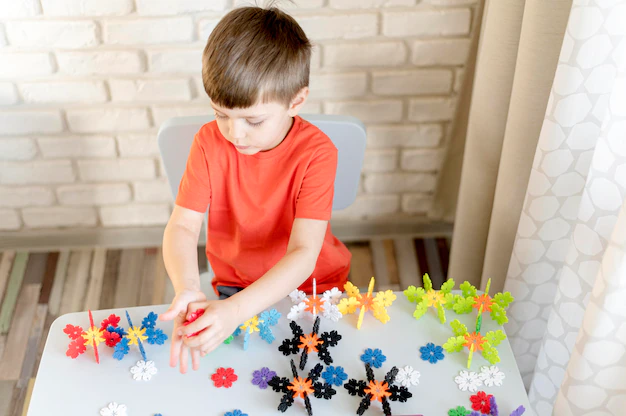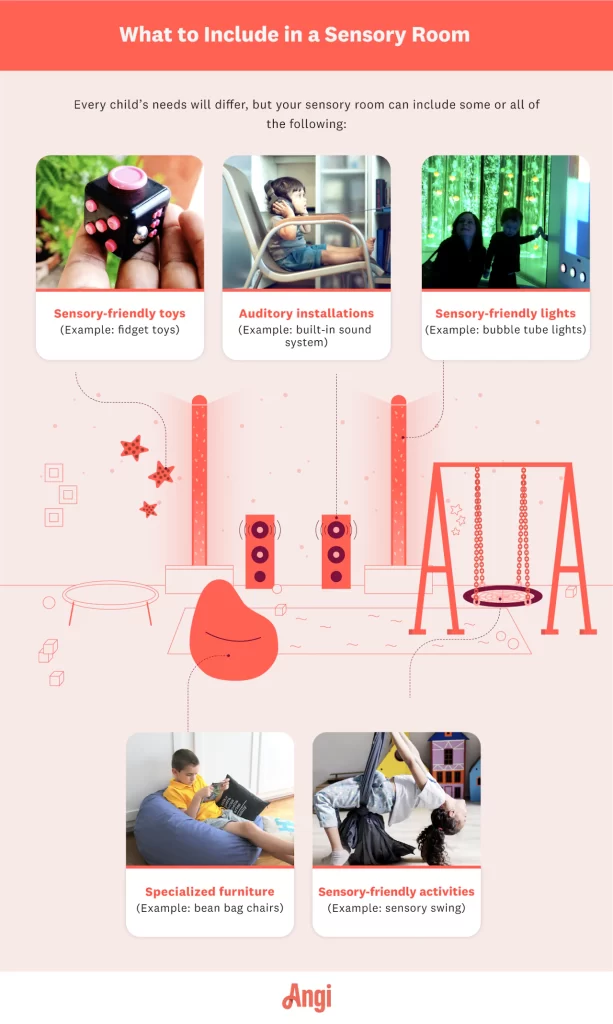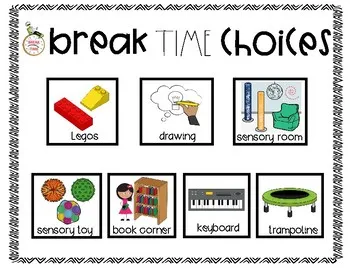5 Sensory Room Ideas for Your Child’s Room
Sharing is caring!

A sensory room is an excellent tool for children with sensory processing disorders. With specialized tools such as programmable LED strip lighting and calming colors, these rooms are a safe space for many children.
If you don’t have the extra room to create a standalone sensory space, don’t worry. Your child’s room easily converts into a sensory bedroom that contains all of the best features of a standard sensory area.
With some planning (and some potential furniture rearranging), your child’s room can be transformed into their personal soothing sanctuary. Here are five sensory integration ideas that are perfect for a child’s room.

Lighting in a Sensory Room
Lights pose many triggering issues to children with sensitivities. In a sensory bedroom, avoid bright-white lights or those that flash or blink. Instead of traditional bulbs, consider sensory-pleasant alternatives such as the following:
- Programmable LED smart bulbs ensure the perfect color depending on your child’s current mood.
- Gently glowing fiber-optic strands are soft and safe to handle. Also, they come in many shapes, from sprays to curtains.
- Bubble tubes create fascinating light displays that help children stay calm and regulate.
Sensory-friendly lighting is an easily achievable goal, and starting with the lights creates an immediate effect within your child’s room.
Choose Calming Colors for the Sensory Room
Like lighting, the color of a room influences its mood. Bold, loud colors (like red and yellow) excite and agitate. In some children, these are moods best avoided.
Opting for a color palette based on cool and earthy tones helps ensure a tranquil room. Blues, purples, and greens have short wavelengths, causing less stimulation to the brain. Therefore, these colors are great for establishing a peaceful mood.
Pastels, such as light pinks and blues, help calm overstimulated children. In a bedroom, these colors promote a more restful sleep, which is essential for children with sensory issues.
Neutral and earth tones include gray, brown, and tan. These colors make great accent shades to help tie a room together. Light earth tones also make excellent replacement colors for typically-white surfaces, like paper.
Personalize the Surfaces
Tactile defensiveness is common in children with a range of sensory issues. Some believe that a puffy cushion or a squishy bean bag chair provides endless comfort. Others cringe at the feeling of certain fabrics and textures.
In the bedroom, comfort and safety are the utmost goals. Personalize all surfaces, from bedspreads to carpets, to surfaces that help or even soothe your child. Be sure to bring in specialized tools, including:
- Weighted blankets to provide deep-touch pressure and a feeling of safety during the night.
- Body socks for in-place comfort and body-hugging safety.
- Sensory wall panels with programmable lighting, play surfaces, and speakers to incorporate several angles of sensory integration.
For active children prone to hyperactivity, cover the floor with crash mats. These soft surfaces allow your kids to play, roll, and have safe fun while they work off their energy. Soft convertible chairs and couches provide surfaces of comfort. Rugs add easy-to-incorporate sensory additions based on your child’s needs.
Focus on the Sounds
Some children thrive under the constant drone of white noise. Others find the most peace while gentle nature sounds play in the background. Still, some enjoy complete silence. Luckily, there are auditory tools to help everyone.
Smart devices allow parents and kids to control the room’s sounds. Plus, they play an endless variety of sensory-sensitive sounds.
For those who avoid sounds, consider soundproofing or acoustic panels to minimize sharp noises and echoes within the room. Noise-canceling headphones and earplugs do this as well, but these might cause other sensory issues in some children.
Specialized equipment like vibroacoustic boards go one step further: they turn sound into a tactile experience. With these, your child can feel many different sounds, from music to the sound of water. These have shown promising results in calming children with sensory issues.
Safe Exercise Tools in the Sensory Room
Every child needs to blow off steam. Providing safe surfaces and equipment in a child’s room is an excellent idea for several reasons. These include:
- Promoting activity, skill-building, and enhanced self-confidence.
- Encouraging healthy play habits while enhancing coordination, motor skills, and independent functioning.
- Creating safe tools for children to burn excess energy, or regulate a meltdown.
The list of safe and active sensory equipment is long, and constantly growing. Exercise balls have several uses, from calming yoga platforms to active exercise equipment. Other simple pieces of equipment, like jump ropes and mini-trampolines, combine exercise with fun to prompt kids to move.
For more low-impact equipment, look at hanging options. Hammocks, cocoon chairs, and sensory swings provide unique sensory experiences. As well, they help calm and regulate children through the comfortable feeling of floating.
Final Thoughts
The items in your child’s room should cater to their sensory needs. They should encourage your child to explore, experience, and enjoy themselves. Ultimately, they should create a welcoming space for your child.
Take the time to design and plan their sensory-integrated room with your child. It’s a wonderful moment of bonding and connection. It helps teach your kids several valuable lessons, and it provides them with the safe space they deserve.
If you are looking for a choice board to support students in using the sensory room and the items inside I recommend checking this out!




